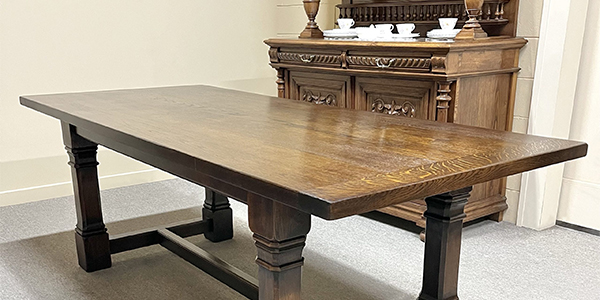
More than just a nostalgic assortment of old and valuable pieces, antique furniture is a testament to the craftsmanship, ingenuity, and aesthetics of bygone eras. Such exquisite items are a glimpse into our past, reflecting the styles, materials, and artistry prevalent at the time of creation. Antique furniture holds cultural and historical significance along with a timeless appeal. This makes it highly sought-after by collectors, enthusiasts, and interior designers. Antique pieces exude raw beauty and charm that’s unparalleled by modern furniture.
What Does Antique Furniture Mean?
Often interchanged with ‘vintage’ and ‘retro’, the word ‘antique’ is typically reserved for furniture that is more than 100 years old. Pieces that have survived the test of time, been cherished by their owners, and passed down from generation to generation with their beauty intact tend to be the definition of antique. The most coveted antiques are the ones that have been crafted from the finest materials, such as mahogany, rosewood, walnut, and oak. Such furniture may feature intricate carvings, inlays, and various types of embellishments that reveal the design sensibilities of the period. Some of the most popular styles of antique furniture include Queen Anne, Chippendale, Victorian and Georgian.
Why Antique Furniture is Rare and Valuable
If you are new to the world of antiques or hoping to find one for your home, you’ll notice that antique furniture stores are priced rather high. So, what is it that makes these items so exceptional? Here are a few reasons why people might prefer to buy antique furniture:
- Age and Rarity: Antique furniture is typically over 100 years old, making it rare and hard to find.
- Craftsmanship and Quality: Antique pieces were often handmade by skilled craftsmen using traditional techniques and high-quality materials. This results in exceptional beauty and durability.
- Design and Style: Such furniture represents different periods and styles. It showcases unique design elements and aesthetics that are no longer commonly produced.
- Historical and Cultural Significance: It provides a glimpse into the past, reflecting the history, culture, and societal norms of the time it was created.
- Collectable: Antiques are highly sought after by collectors, creating a demand that contributes to their value and rarity. Moreover, it has the potential to appreciate in value over time.
How to Take Care of Antique Furniture
Maintaining the quality of antique pieces requires special attention and consideration. Depending on the age and condition, they may be delicate and susceptible to damage from exposure to sunlight, moisture, temperature changes etc. Whether it’s a French antique or a relic of the Elizabethan Age, taking proper care of wooden furniture is pretty simple. Here are some basic tips for antique maintenance:
- Dust the furniture with a soft brush for basic maintenance
- Use a mild detergent with diluted water and wipe along the grain if you need to wet clean
- After wet cleaning, pat each area dry with a clean cloth to remove all traces of moisture
- Avoid wiping this furniture with only water as moisture can cause damage to old wood.
- Keep antique furniture away from direct sunlight and heat sources.
Where Can You Buy Antique Furniture?
Buying antique furniture demands some careful research and an eye for detail. Streets and flea markets around the world teem with replacements and cheap knockoffs that emulate the look of the original. However, most are unable to capture the craftsmanship and longevity of the original pieces. Before stepping into an antique furniture store in Melbourne or browsing for it online, it’s best to ensure that the pieces are indeed authentic. You can do this by checking for signs such as:
- Dovetailing: Check for dovetail joints, a technique used by older woodworkers to hold parts together.
- Multiple types of wood: Genuine antique pieces may feature valuable wood in visible areas.
- Labels and stamps: Any markings on the underside or inside indicating the year of production.
- Lack of symmetry: Antique furniture is meant to be handmade and therefore can have imperfect symmetry.
When purchasing antique furniture, it’s essential to do thorough research, examine the condition, and ensure authenticity. Reputable stores offer a wide range of options and provide information about the piece’s history and provenance. To buy the most tasteful and well-maintained antique furniture for your home in Melbourne, Australia, you can start with the rare assortment at Nostalgia Antiques. If items belonging to the early 19th to the mid-20th century have caught your fancy, our collection’s got you covered. You can contact us on 03 9480 3745 or 0411 136 816 for more details.